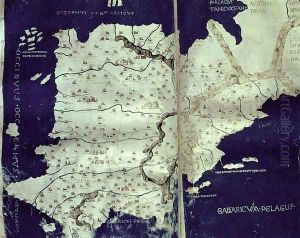Ptolomeus, Claudio Paintings
Claudius Ptolemy was not primarily known as an artist but as a Greco-Roman mathematician, astronomer, geographer, and astrologer. He lived in the city of Alexandria in the Roman province of Egypt under the rule of the Roman Empire, a period during which Alexandria was a major center of knowledge and learning. Ptolemy's contributions to the arts, particularly cartography, stem from his work in geography and astronomy.
Ptolemy's most famous work is the 'Almagest,' a comprehensive treatise on astronomy that remained the authoritative reference on the subject for many centuries. In the realm of geography, his work 'Geographia' was immensely influential. It provided a detailed record of the world as it was known to the Romans, complete with maps and coordinates. These maps, although based on the knowledge of the time and containing many inaccuracies, were a blend of art and science, representing the known world through the cartographic conventions that Ptolemy developed.
While Ptolemy's maps themselves have not survived, the instructions he provided allowed later generations to recreate his vision of the world. His work on cartography was based on the use of a grid system - longitude and latitude - which was an innovative method for his time and had a lasting impact on the field. The 'Geographia' also included a gazetteer, giving the coordinates for the places listed, which was an essential resource for mapmaking.
Ptolemy's influence extended beyond his lifetime into the Renaissance, where his work on cartography would help inform the Age of Discovery. Although today his geography is recognized for its inaccuracies, it was a remarkable achievement for its time and laid the foundations for the modern discipline of cartography. Ptolemy's blend of scientific rigor and the artistic representation of the world make him a figure of interest not only in the history of science but also in the history of art, particularly in the specialized field of the history of maps.
